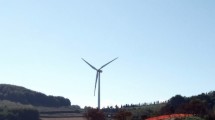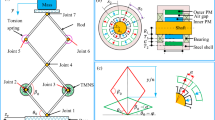Abstract
With the rapid increase in scales of structures, research on controlling wind-induced vibration of large-scale structures, such as long-span bridges and super-tall buildings, has been an issue of great concern. For wind-induced vibration of large-scale structures, vibration frequencies and damping modes vary with wind speed. Passive, semiactive, and active control strategies are developed to improve the wind-resistance performance of the structures in this paper. The multiple tuned mass damper (MTMD) system is applied to control vertical bending buffeting response. A new semiactive lever-type tuned mass damper (TMD) with an adjustable frequency is proposed to control vertical bending buffeting and torsional buffeting and flutter in the whole velocity range of bridge decks. A control strategy named sinusoidal reference strategy is developed for adaptive control of wind-induced vibration of super-tall buildings. Multiple degrees of freedom general building aeroelastic model with a square cross-section is tested in a wind tunnel. The results demonstrate that the proposed strategies can reduce vibration effectively, and can adapt to wind-induced vibration control of large-scale structures in the uncertain dynamic circumstance.
Similar content being viewed by others
References
Wardlaw R. The improvement of aerodynamic performance. In: Larsen A, ed. Aerodynamics of Large Bridges. Rotterdam: Balkema, 1992, 59–70
Wilde K, Fujino Y. Aerodynamic control of bridge deck flutter by active surfaces. J Eng Mech, ASCE, 1998, 124(7): 718–727
Wilde K, Fujino Y, Kawakami T. Analytical and experimental study on passive aerodynamic control of flutter of a bridge deck. J Wind Eng Indust Aerodyn, 1999, 80: 105–119
Gu M, Xiang H F, Lin Z X. Flutter-and buffeting-based selection for long-span bridges. J Wind Eng Indust Aerodyn, 1999, 80: 373–382
Nobuto J, Fujino Y, Ito M. A study on the effectiveness of T.M.D. To suppress a coupled flutter of bridge deck. In: Proceedings of Japan Society of Civil Engineering, 1998, 398/1–10: 413–416
Gu M, Chang C C, Wu W, Xiang H F. Increase of critical flutter wind speed of long-span bridges using tuned mass dampers. J Wind Eng Indust Aerodyn, 1998, 73: 111–123
Lin Yuh-Yi, Cheng C M, Lee C H. Multiple tuned mass dampers for controlling coupled buffeting and flutter of long-span bridges. Wind & Structures, An International Journal, 1999, 2(4): 267–248
Saeid P, Datta T K. Control of flutter of suspension bridge deck using TMD. Wind & Structures, An International Journal, 2002, 5(5): 407–422
Gu M, Xiang H F. Optimization of TMD for suppressing buffeting response of long-span bridges. J Wind Eng Indust Aerodyn, 1992, 42: 1383–1392
Gu M, Xiang H F, Chen A R. A practical method of passive TMD for suppressing wind-induced vertical buffeting of long-span cable-stayed bridges and its application. J Wind Eng Indust Aerodyn, 1994, 51: 203–213
Gu M, Chen S R, Chang C C. Parametric study on multiple tuned mass dampers for buffeting control of Yangpu Bridge. J Wind Eng Indust Aerodyn, 2001, 89: 987–1000
Chang C C, Gu M, Tang K H. Tuned mass dampers for dual-mode buffeting control of bridges. J Bridge Eng, ASCE, 2003, 8(4): 237–240
Chen S R, Cai C S, Gu M, Chang C C. Optimal variables of TMDs for multi-mode buffeting control of long-span bridges. Wind & Structures, An International Journal, 2003, 6(5): 387–402
Gu M, Chen S R, Chang C C. Control of wind-induced vibrations of long-span bridges by semi-active lever-type TMD. J Wind Eng Indust Aerodyn, 2002, 90: 111–126
Burdisso R A, Suarez L E, Fuller C R. Feasibility study of adaptive control of structures under seismic excitation. Journal of Engineering Mechanics, 1994, 120(3): 580–592
Burdisso R A. Structural attenuation due to seismic inputs with adaptive hybird control system. Applied Mechanics Review, 1995, 48(Suppl 11): 143–149
Ma K G, Chen X, Gu Z, Gu M. Adaptive control of wind-induced vibration of flexible civil structures: Methods and experiments. Journal of Vibration Engineering, 1998, 11(2): 1–7 (in Chinese)
Scanlan R H, Tomko J J. Airfoil and bridge deck flutter derivatives. J Eng Mech Div, ASCE, 1971, 97(6): 1712–1737
Igusa T, Xu K. Vibration reduction characteristics of distributed tuned mass dampers. In: Petyt M, et al, eds. Proceedings of the 4th International Conference on Recent Advances in Structural Dynamics, Southampton, UK, 1991, 596–605
Current Code for Design of Bridges and Culverts—Code of the Ministry of Communications of China. JTJ-021-89. Renming Jiaotong Press, 1989 (in Chinese)
Gu M, Chen S R, Chang C C. Buffeting control of the Yangpu Bridge using multiple tuned mass dampers. In: A Larsen, G L Larose, F M Livesey, eds. Proceedings of the 10th International Conference on Wind Engineering. Rotterdam: Balkema, 1999, 893–898
Gu M, Xu Y L, Chen L Z, Xiang H F. Fatigue life estimation of steel girder of Yangpu Cable-Stayed Bridge due to buffeting. J. Wind Eng Indust Aerodyn, 1999, 80: 383–400
Peng F J, Gu M, Niemann H-J. Sinusoidal reference strategy for adaptive feedforward vibration control: Numerical simulation and experimental study. Journal of Sound and Vibration, 2003, 265(5): 1047–1061
Peng F J, Gu M, Niemann H-J. Study on sinusoidal reference strategy-based adaptive feedforward control applied to benchmark wind-excited building. J Eng Mech, ASCE, 2004, 130(4): 518–523
Widrow B, Stearns S D. Adaptive Signal Processing. Englewood Cliffs, NJ: Prentice-Hall, Inc., 1985
Gu M, Peng F J. An experimental study of active control of wind-induced vibration of super-tall buildings. Journal of Wind Engineering and Industrial Aerodynamics, 2002, 90(12–15): 1919–1931
Author information
Authors and Affiliations
Corresponding author
Rights and permissions
About this article
Cite this article
Gu, M. Control of wind-induced vibration of long-span bridges and tall buildings. Front. Archit. Civ. Eng. China 1, 51–62 (2007). https://doi.org/10.1007/s11709-007-0005-3
Received:
Accepted:
Issue Date:
DOI: https://doi.org/10.1007/s11709-007-0005-3




